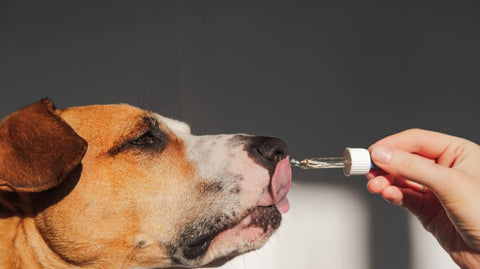

Key Highlights
- Glucosamine is a popular joint supplement for cats and dogs, known for its benefits in promoting joint health and reducing joint pain.
- It is a natural nutritional supplement that contains active ingredients such as glucosamine, chondroitin, and MSM to support healthy joints.
- Glucosamine can be especially beneficial for young pets, as it helps support their joint health from an early age and prevents future joint issues.
- For senior pets, glucosamine can alleviate symptoms of arthritis and hip dysplasia, improving mobility and enhancing their quality of life.
- There are different forms of glucosamine available, such as liquid and powdered, each with its own pros and cons.
- Administering glucosamine to pets is easy with recommended dosage guidelines, and it can be added to their food or given as a chewable treat.
Introduction
Glucosamine has become increasingly popular as a joint supplement for both cats and dogs. Many pet owners are turning to glucosamine to support their pet's joint health and provide relief from joint pain. But what exactly is glucosamine and why is it important for our furry friends? In this blog, we will explore the benefits of glucosamine for cats and dogs, including its role in promoting joint health and its effects on young and senior pets. Glucosamine, along with other important ingredients such as hyaluronic acid, can provide support for dog's and cat’s joints, cartilage lubrication, and mobility, making it a crucial supplement for pets of all ages.
Glucosamine is a natural nutritional supplement that is commonly used to support joint health in both humans and animals. It is a compound that is naturally found in the body and plays a crucial role in the formation and repair of cartilage. Cartilage is a flexible connective tissue that cushions the joints and allows for smooth movement.
As pets age, their bodies may produce less glucosamine, leading to joint problems and discomfort. This is where glucosamine supplements come in. By providing additional glucosamine, these supplements can help support and maintain healthy joints, reduce inflammation, and alleviate joint pain.
Understanding the importance of glucosamine for our pets' joint health is for ensuring their overall well-being. Whether you have a young pet that needs preventative care or a senior pet experiencing mobility issues, glucosamine can provide numerous benefits. Let's delve deeper into the world of glucosamine and discover the specific advantages it offers for cats and dogs.
Understanding Glucosamine and Its Importance for Pets
Glucosamine is a nutritional supplement that contains active ingredients such as glucosamine (USP), chondroitin, and MSM. These ingredients are known for their beneficial effects on joint health, making glucosamine a popular choice for pet owners looking to support their pets' mobility and overall well-being. Glucosamine is a natural compound that is found in the body, particularly in the cartilage of the joints. It plays a crucial role in the formation and repair of cartilage, which is essential for maintaining healthy joints. By providing additional glucosamine (USP) and manganese, sourced from shellfish and other animals, through supplements, pet owners can help support their pets' joint health and reduce the risk of joint problems.
What is Glucosamine?
Glucosamine is a joint health supplement that is commonly used for both cats and dogs. It is a natural compound that is found in the body, particularly in the cartilage of the joints. Glucosamine plays a crucial role in maintaining healthy joints by supporting the formation and repair of cartilage.
As pets age, their bodies may produce less glucosamine, leading to joint problems and discomfort. Glucosamine supplements provide additional glucosamine to help support joint health and reduce the risk of joint problems.
Glucosamine supplements for pets are typically made from natural ingredients and are available in various forms, including tablets, capsules, and liquids. These supplements can be an effective way to support your pet's joint health and maintain their mobility and overall well-being.
It is important to note that glucosamine supplements should not be used as a substitute for veterinary care. If your pet is experiencing joint problems or discomfort, it is always best to consult with a veterinarian for a proper diagnosis and treatment plan.
articlebanners1
The Role of Glucosamine for Cats and Dogs
Glucosamine plays a vital role in promoting pet health, particularly in maintaining healthy joints. It helps to support the production of cartilage, which acts as a cushion between the bones in a joint. As pets age or experience joint issues, their natural production of glucosamine may decrease, leading to joint discomfort and reduced mobility. Supplementing with glucosamine can provide the necessary building blocks to support the production of healthy cartilage and maintain joint function. By incorporating glucosamine into their daily routine, pet owners can help to promote healthy joints, improve mobility, and enhance their pet's overall quality of life.
The Benefits of Glucosamine for Young Pets
Glucosamine offers several benefits for young pets, especially in terms of joint health. By starting a glucosamine supplement early on, pet owners can take preventative measures to support their pet's joint health. It can help to maintain the integrity of their joints, reduce the risk of future joint issues, and enhance their overall mobility. Additionally, glucosamine can provide additional support during periods of growth and development when young pets may experience more strain on their joints. It is a proactive approach to ensure long-term joint health and well-being for young pets.
Supporting Joint and Cartilage Health from an Early Age
Supporting joint health from an early age is essential for the overall well-being of pets. By incorporating glucosamine into their daily routine, pet owners can take preventative measures to support their pet's joint health. Glucosamine helps to maintain the integrity of joints, reduces the risk of future joint issues, and promotes healthy mobility. Starting a glucosamine supplement early on can provide the necessary building blocks to support the production of healthy cartilage and ensure optimal joint function. By taking proactive measures, pet owners can give their pets the best chance at maintaining healthy joints throughout their lives.
Preventative Measures for Future Joint Issues
Prevention is key when it comes to future joint issues in pets. By incorporating glucosamine into their pet's daily routine, pet owners can take preventative measures to support their pet's joint health. Glucosamine acts as a joint supplement that provides the necessary building blocks for healthy cartilage production. It helps to maintain the integrity of joints, reduce the risk of future joint issues, and promote optimal joint function. By starting a glucosamine supplement early on, pet owners can provide their pets with the support they need to maintain healthy and mobile joints throughout their lives.
How Senior Pets Benefit from Glucosamine
Senior pets, such as cats and dogs, can greatly benefit from the use of natural glucosamine. As pets age, their joints may become stiffer, and they may experience joint discomfort and reduced mobility. Glucosamine supplements can help to alleviate the symptoms of arthritis and hip dysplasia in senior pets, improving their overall quality of life. By incorporating natural glucosamine into their daily routine, pet owners can provide their senior pets with the necessary support for healthy joints, enhanced mobility, and increased comfort.
Alleviating Symptoms of Arthritis and Hip Dysplasia
Arthritis and hip dysplasia are common issues that senior pets may face. Glucosamine can help to alleviate the symptoms associated with these conditions, such as joint pain and soreness. By providing the necessary building blocks for healthy cartilage production, glucosamine supports joint health and improves mobility in senior pets. It helps to reduce inflammation in the joints, providing relief from discomfort and promoting overall well-being. Senior pets can experience enhanced comfort and increased mobility with the regular use of glucosamine supplements.
Enhancing Mobility and Quality of Life in Older Pets
Older pets often experience a decline in mobility as they age. Glucosamine supplements can play a vital role in enhancing mobility and improving the quality of life for older pets. By supporting the production of healthy cartilage and reducing joint inflammation, glucosamine helps to maintain joint function and alleviate discomfort. This can result in improved mobility, making it easier for older pets to move around and engage in their daily activities. By incorporating glucosamine into their pet's routine, pet owners can provide their older pets with the support they need to enjoy a comfortable and active life.
articlebanners2
Liquid vs. Powdered Glucosamine Supplement: Which is Better?
When it comes to choosing between liquid and powdered glucosamine, it ultimately depends on the preferences of the pet and the pet owner. Liquid glucosamine is often easier to administer, as it can be mixed into the pet's food or given directly into the mouth. It is also quickly absorbed by the body, allowing for faster results. On the other hand, powdered glucosamine can be mixed into the pet's food as well, but some pets may be more hesitant to consume it, even when sprinkled on their favorite dog or cat food. It is important to consider the pet's preferences and choose the form that is easiest to administer, especially for picky puppies and kitties.
Pros and Cons of Liquid Glucosamine
Liquid glucosamine has several advantages, including:
- Easy administration: Liquid glucosamine can be easily mixed into the pet's food or given directly into the mouth, making it convenient for pet owners.
- Quick absorption: Liquid glucosamine is quickly absorbed by the body, allowing for faster results and effectiveness.
- Easy to adjust dosage: Liquid glucosamine allows for easy adjustment of the dosage, making it suitable for pets of different sizes and needs.
However, there are also a few drawbacks to consider:
- Taste: Some pets may be hesitant to consume liquid glucosamine due to its taste, which can make administration more challenging.
- Storage: Liquid glucosamine may require proper storage conditions to maintain its effectiveness over time.
Pros and Cons of Powdered Glucosamine
Powdered glucosamine also has its own set of advantages:
- Easy mixing: Powdered glucosamine can be easily mixed into the pet's food, allowing for convenient administration.
- Long shelf life: Powdered glucosamine typically has a longer shelf life, making it a good option for pet owners who prefer to purchase in bulk.
- Palatability: Some powdered glucosamine products are formulated to be more palatable to pets, making it easier to administer.
However, there are a few drawbacks to consider:
- Measurement accuracy: It can be challenging to accurately measure the correct dosage of powdered glucosamine, especially for small pets.
- Mixing issues: Some pets may be able to detect the powdered glucosamine and may refuse to consume their food if they dislike the taste.
Administering Glucosamine to Your Pets
Administering glucosamine for cats and dogs to your pets is a straightforward process. It is important to follow the dosage guidelines provided by the product manufacturer or consult with your veterinarian to determine the appropriate dosage for your pet based on their weight and age. Glucosamine supplements can be easily mixed into your pet's food or given directly into their mouth. For some pets, a loading dose may be recommended for the first week to provide an initial boost of glucosamine. Overall, administering glucosamine to your pets is a simple and effective way to support their joint health.
Dosage Guidelines for Cats and Dogs
The dosage of glucosamine for cats and dogs can vary based on their weight and age. It is important to follow the recommended dosage guidelines provided by the product manufacturer or consult with your veterinarian for the most accurate dosage information. Typically, the dosage is based on the pet's weight, with smaller pets requiring a lower dosage and larger pets requiring a higher dosage, usually measured in ml. It is important to start with the recommended dosage and adjust as needed based on your pet's response and any guidance from your veterinarian. Additionally, some products may also contain other beneficial ingredients for pets, such as taurine, which can provide numerous health benefits for cats and dogs. Remember to always read the product label and follow the instructions provided.
Tips for Easy Administration
Administering glucosamine to your pets can be made easier with a few tips and tricks. Here are some suggestions to ensure easy administration:
- Use soft chews: Soft chews are a popular option for pets, as they can be easily given as a treat and are often palatable.
- Mix with wet food: If your pet is a picky eater, consider mixing the glucosamine supplement with their wet food to mask any taste or texture.
- Try a liquid formula: Liquid glucosamine can be easily mixed into the pet's food or given directly into their mouth, making it a convenient option.
- Monitor your dog's and cat's joints: Regularly check your cat's joints for any signs of discomfort or stiffness. If you notice any issues, consult with your veterinarian for guidance on administering glucosamine.
Real-life Success Stories of Pets on Glucosamine
Real-life success stories of pets on glucosamine highlight the positive impact it can have on their quality of life. Many pet owners have seen transformations in their pets' mobility and overall well-being after incorporating glucosamine into their daily routine. Pets that were once limited by joint discomfort and reduced mobility have experienced increased comfort and improved movement. Glucosamine has allowed these pets to live a more active and pain-free life, providing them with the joy and freedom they deserve.
articlebanners4
Case Studies of Younger Pets Benefiting from Glucosamine
Case studies of younger pets benefiting from glucosamine have shown the importance of starting joint health support early on. By incorporating glucosamine into their daily routine, pet owners can provide their younger pets with the necessary support for healthy joints and prevent future joint issues. These case studies have highlighted the positive impact of glucosamine on joint health, mobility, and overall well-being in younger pets. Starting joint health support early can ensure that pets maintain optimal joint function and enjoy a comfortable and active life.
Transformations Seen in Senior Pets
Senior pets can experience remarkable transformations with the use of glucosamine. Glucosamine supplements for dogs and cats have been shown to provide enhanced mobility and relief from arthritis symptoms in older pets. These transformations often involve increased comfort, improved mobility, and a better quality of life. Senior cats that were once limited by joint discomfort and reduced mobility can experience a renewed sense of freedom and vitality. Glucosamine, which is approved by the FDA as a dietary supplement, plays a crucial role in maintaining joint health and supporting overall well-being in older cats and dogs.
The Science Behind Glucosamine: How It Works
The science behind glucosamine reveals its biological impact on joint health. Glucosamine is a natural compound found in the cartilage of joints and is involved in the production of healthy cartilage. It supports the integrity of joints and helps to reduce inflammation. Clinical studies have shown the efficacy of glucosamine in promoting joint health and improving mobility, making it a valuable option for those suffering from osteoarthritis. By providing the necessary building blocks for cartilage production, glucosamine supports joint function and overall joint health.
The Biological Impact of Glucosamine on Joints
Glucosamine has a biological impact on joints, particularly in the production of healthy cartilage. Cartilage is an essential component of joints and acts as a cushion between bones. Glucosamine supports the production of cartilage and helps to maintain its integrity. It provides the necessary building blocks for the production of collagen, a protein that gives cartilage its strength and structure. By supporting the production of healthy cartilage, glucosamine plays a vital role in promoting joint health and overall joint function.
Potential Side Effects and Considerations
While glucosamine is generally safe for pets, there are some potential side effects and considerations to keep in mind. Some pets may experience mild gastrointestinal upset, such as diarrhea or allergies, when first starting glucosamine supplementation. It is important to monitor your pet for any adverse reactions and consult with your veterinarian if you have concerns. Additionally, if your pet is on any other medications, it is advisable to consult with your veterinarian before starting glucosamine to avoid any potential drug interactions. Your veterinarian can provide guidance on the appropriate use and administration of glucosamine for your pet.
Common Side Effects of Glucosamine in Pets
Glucosamine is generally safe for pets, but some common side effects may occur. These can include mild gastrointestinal upset, such as diarrhea, and allergies. If your pet experiences any of these side effects, it is important to consult with your veterinarian. They can provide guidance on managing these side effects or suggest alternative joint supplements if necessary. It is always important to closely monitor your pet's response to any new supplement and seek veterinary advice as needed.
When to Consult a Veterinarian
It is important to consult with your veterinarian in certain situations when using glucosamine for your pet. If your pet experiences any adverse reactions to glucosamine, such as severe gastrointestinal upset or allergic reactions, it is important to seek veterinary advice. Additionally, if your pet is on any other medications, it is advisable to consult with your veterinarian to ensure that there are no potential drug interactions between the medications. Your veterinarian can provide guidance on the appropriate use and administration of glucosamine for your pet based on their specific needs and health conditions.
Conclusion
Glucosamine offers a world of benefits for our furry companions, from supporting joint health to enhancing mobility and quality of life, whether they're young or senior pets. Understanding the importance of this supplement can make a significant difference in their overall well-being. Whether in liquid or powdered form, administering the right dosage can positively impact their joint health. Real-life success stories further highlight the transformative effects of glucosamine on pets. By incorporating this supplement into their routine, you're investing in their long-term health and happiness. Remember, consulting your vet for personalized advice is always a wise decision.
Frequently Asked Questions
How Long Does It Take to See Results from Glucosamine?
The time it takes to see results from glucosamine can vary depending on the pet's individual health and condition. Some pets may experience improvement within a few weeks, while others may take longer. It is important to be consistent with the use of glucosamine and give it sufficient time to work. A loading dose may be recommended for the first week to provide an initial boost of glucosamine.
Can All Breeds of Cats and Dogs Benefit from Glucosamine?
Yes, glucosamine can benefit all breeds of cats and dogs. Joint health is important for all pets, regardless of their breed. Glucosamine supplements can provide support for joint health and mobility, making it beneficial for all cats and dogs, regardless of their size or breed.
articlebanners3




